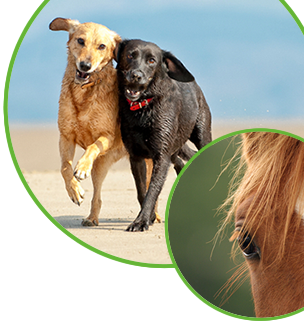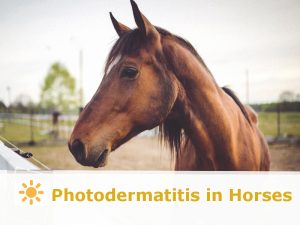
Photodermatitis in Horses

Photodermatitis or photoallergy is a sensitivity to sun exposure that affects the horse's skin. It is caused by contact with a chemical or plant that contains photodynamic agents (photosensitisers), followed by exposure to ultraviolet light.
Contact with the chemicals or plants that lead to photoallergy can be topical, by ingestion or injection. The photodynamic agents are deposited in the skin and when the horse is exposed to sunlight these molecules cause damage to the cell membranes of the skin. These reactive compounds can be found in some drugs (e.g. antibiotics and tranquilizers), fly sprays, coat conditioners, and plants, such as St John's Wort, rye, other weeds and grasses, and some clovers.
This type of reaction is called primary photodermatitis. There is also another type of photosensitivity called secondary photodermatitis which is caused by underlying liver disease. Liver damage is often associated with the ingestion of high amounts of clover and alfalfa, as well as bacterial, viral, or fungal infections, and even liver cancer. Failure in the normal function of the horse's liver can lead to the presence of photosensitive pigments in the tissues, which will then be affected by ultraviolet light exposure, and cause skin damage. Common signs of liver disease include decreased appetite, lethargy, weight loss, and jaundice (yellow colour of the eyes and gums).
This abnormal reaction of the skin results in redness, swelling, itching, pain, scabs and crusts. In more severe cases the damage to the skin can include peeling skin, blisters and sores. In the early stages of this disease owners often realise their horse is becoming reluctant to wear a halter or bridle. The most affected areas of horses that photosensitive are usually the horse's face (eyelids and lips), the perineum, and the extremities. This condition can affect both pigmented and non-pigmented areas of the body.
If you notice your horse is showing any signs of pain or damage to the skin consult your vet. It is very important to treat the clinical signs and to locate the source of the problem in order to prevent it.
It is also recommended to keep your horses safe from excessive sun exposure. Have a look at our previous post and follow our tips to protect your horses from the sun.
Would you like to know more about horses? Check our Equine Courses:
Equine courses
Published: 30 Jul 2016
Read the previous article: Aggression in cats

